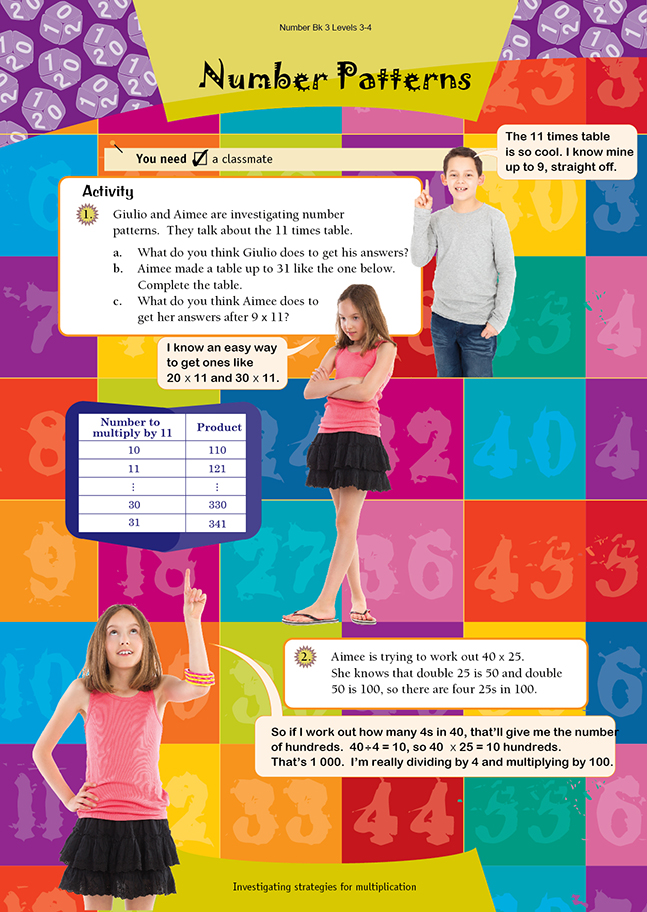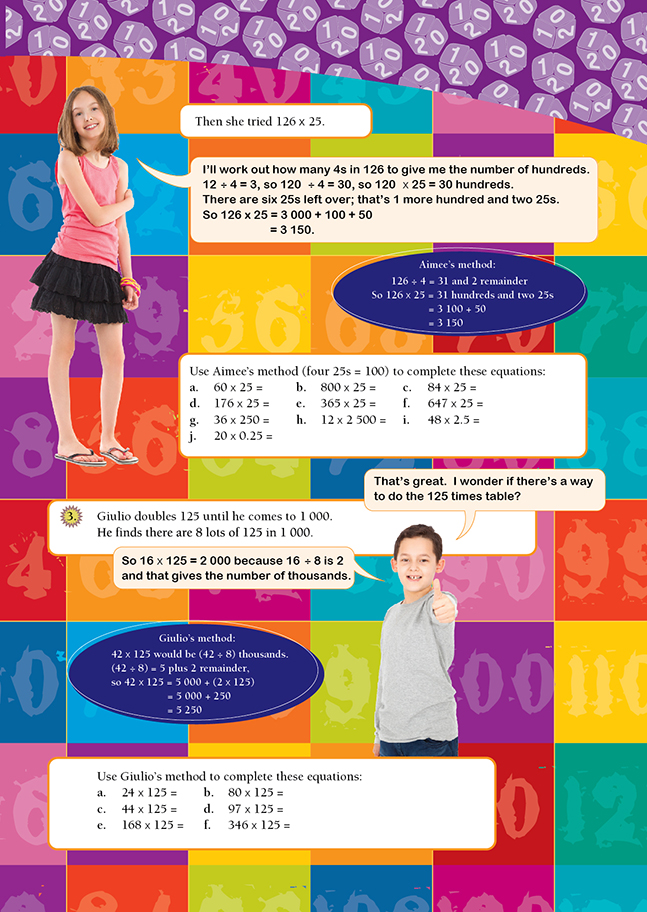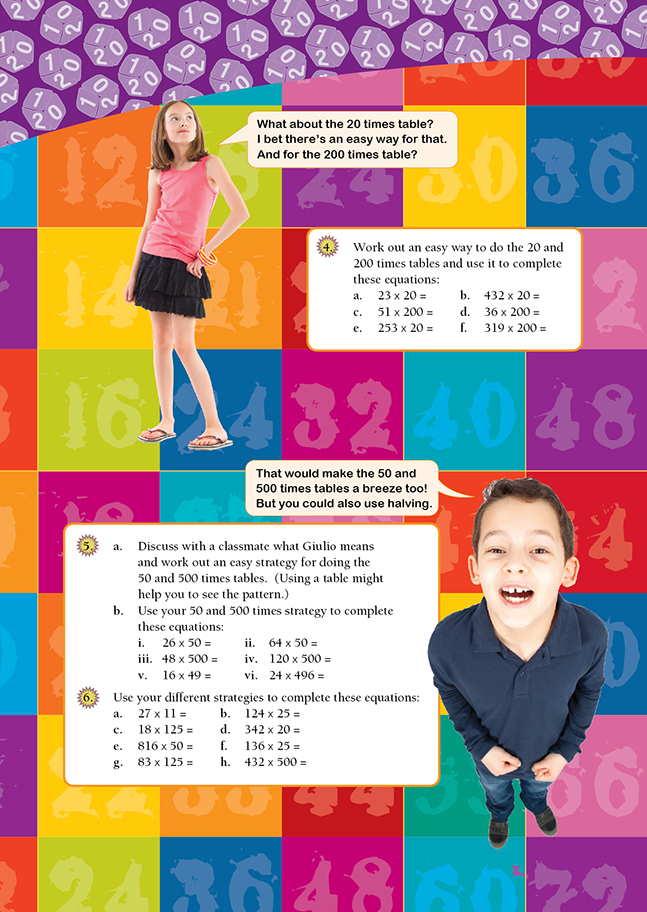This is a level 4 number activity from the Figure It Out series. It relates to Stage 7 of the Number Framework.
A PDF of the student activity is included.
Click on the image to enlarge it. Click again to close. Download PDF (1.3 MB)
investigate strategies to solve multiplication problems
FIO, Level 3-4, Number, Book 3, Number Patterns, pages 8-10
A classmate
This activity focuses on strategies that students develop in transition from advanced additive to advanced multiplicative.
Students usually enjoy investigating number patterns and are happy to use them once they realise that it’s often quicker to use mental strategies than a calculator. Encourage the students to also investigate why the patterns work out as they do. In other words, what is the mathematics behind the patterns?
The tasks in question 1 all have to do with the 11 times table. The 11 times table results in a rather nice pattern (11, 22, 33, 44, and so on), which the students could explore to identify the underlying mathematics. Some may work out for themselves, and be able to share with others, that, for example, 3 x 11 is really 3 x (10 + 1). This in turn is the same as (3 x 10) + (3 x 1), which is 33.
The mathematical principle being used here is the distributive principle. The 11 is being renamed as 10 + 1, and the multiplication is being distributed across the addition. This idea has its beginnings in the junior school, where students are helped to realise (perhaps with the use of Cuisenaire™ rods) that 2 lots of, say, 6 is the same as 2 lots of 5 and 2 lots of 1.
In question 1, the students have to work out how Aimee gets her answers after 9 x 11. (See the explanation in the Answers.) Aimee’s table goes only to 31, but you could explore some higher 2-digit multiples with the students. For example, with 11 x 86 = 946, the total of 8 and 6 is 14, so the 8 that would normally be in the hundreds column has a extra 1 added to it and becomes 9.
Question 2 also supports the students in developing number sense. Recognising that there are four 25s in 100 (or that 25 is 1/4 of 100) is very helpful when it comes to multiplying numbers by 25.
Challenge the students to find other ways of mentally calculating the 40 x 25 mentioned at the beginning of question 2. For instance, they may rename the 40 as 4 x 10, so the example becomes 4 x 10 x 25 (or 4 x 250) or 10 x 4 x 25 (or 10 x 100). This strategy is known as proportional adjustment or “reunitising”, where the total is “repackaged” into easier units.
Questions 2a–f can all be calculated mentally using the strategy outlined in the question itself or the other strategies described above. Questions 2g–j involve multiplying by numbers that are related to 25 rather than by 25 itself. Thus, 250 is 25 x 10, 2 500 is 25 x 100, 2.5 is 25 ÷ 10, and 0.25 is 25 ÷ 100. The method in the Answers is based on Aimee’s strategy, but your students could also look at other similar strategies. For example, 36 x 250 is the same as 36 x 100 ÷ 4 x 10 or,
more conveniently, 36 ÷ 4 x 100 x 10, which is 9 x 1 000 or 9 000. Alternatively, if the students recognised that there are 4 lots of 250 in 1 000 (or 250 is 1/4 of 1 000), the process could be shortened to 36 x 1 000 ÷ 4, or 36 ÷ 4 x 1 000, which again is 9 x 1 000.
In question 3, Giulio’s method for multiplying by 125 is based on there being 8 lots of 125 in 1 000, which is the same as 1/8 of 1 000. That is, the 125 can be renamed as 1 000 ÷ 8 and used in this form to multiply with the numbers in questions 3a–f.
Question 4 is about finding a pattern relating to the 20 times table and the 200 times table. The most obvious way is explained in the Answers. A similar strategy can be used for question 5, or the students can rename the 50 as half of 100 (100 ÷ 2) and the 500 as half of 1 000 (1 000 ÷ 2). Reunitising is a critical strategy for calculating multiplication and division problems mentally.
The students will probably notice that, when multiplying by 50, the result is always half of the number being multiplied but expressed in hundreds (for example, 50 x 4 is 2 hundreds), and when multiplying by 500, it is again half of the number being multiplied but expressed in thousands (for example, 500 x 4 is 2 thousands). This pattern can then be used to work out the examples in question 5b. Questions 5b v and vi require a little more thought. These problems could be approached by rounding the 49 to 50 and the 496 to 500 (see the Answers).
Answers to Activity
1. a. He repeats the first digit of the number being multiplied by 11. For example,
9 x 11 = 99.
c. Answers may vary. One way is to write (or visualise) the two digits that are being
multiplied by 11 with a space between them and then add them together to get the middle digit. For example, 24 x 11 = 2 (2 + 4) 4 = 264.
(The pattern is that the 2 digits in the original number become the hundreds and ones
digits respectively of the new number, and the tens digit is the sum of the 2 original
digits.)
2. a. 1 500. (60 ÷ 4 = 15, so 60 x 25 = 15 hundreds.)
b. 20 000. (200 hundreds)
c. 2 100. (21 hundreds)
d. 4 400. (44 hundreds)
e. 9 125. (91 hundreds and one 25)
f. 16 175. (161 hundreds and three 25s)
g. 9 000. (36 ÷ 4 = 9, so 36 x 25 = 9 hundreds; 900 x 10 = 9 000. Or: 4 x 250 = 1 000. 36 ÷ 4 = 9, so 9 x 1 000 = 9 thousands or 9 000.)
h. 30 000. (12 ÷ 4 = 3, so 12 x 25 = 3 hundreds; 300 x 100 = 30 000. Or: 4 x 2 500 = 10 000. 12 ÷ 4 = 3, so 12 x 2 500 = 30 000.)
i. 120. (48 ÷ 4 = 12, so 48 x 25 = 12 hundreds; 1 200 ÷ 10 = 120. Or: 4 x 2.5 = 10; 48 ÷ 4 = 12; 12 x 10 = 120)
j. 5. (20 ÷ 4 = 5, so 20 x 25 = 5 hundreds; 500 ÷ 100 = 5. Or: 4 x 0.25 is 1,
so 20 ÷ 4 is 5 ones.)
3. a. 3 000. (24 ÷ 8 = 3, so 24 x 125 = 3 thousands.)
b. 10 000. (10 thousands)
c. 5 500. (5 thousands and 4 lots of 125)
d. 12 125. (12 thousands and 1 lot of 125)
e. 21 000. (21 thousands)
f. 43 250. (43 thousands and 2 lots of 125)
4. Answers may vary. You could multiply by 10 or 100 and double your answer (for example, 23 x 10 = 230; 230 x 2 = 460) or multiply by 2 and use place value to multiply by 10 or 100 (for example, 23 x 2 = 46; 46 x 10 = 460).
a. 460
b. 8 640
c. 10 200
d. 7 200
e. 5 060
f. 63 800
5. a. Strategies will vary. You could adapt the strategies for 20 and 200 (for example, multiply by 10 or 100 and then multiply your answer by 5), or you could multiply by 100 or 1 000 and halve the answer (26 x 100 = 2 600; 2 600 ÷ 2 = 1 300; so 26 x 50 = 1 300, or, since 50 is half of 100, halve the 26 and call it hundreds, that is, 1 300).
b. i. 1 300
ii. 3 200
iii. 24 000
iv. 60 000
v. 784. (16 x [50 – 1] = 800 – 16, which is 784.)
vi. 11 904. (24 x 1 000 ÷ 2 – 4 x 24 or 24 x [500 – 4] = 12 000 – 96, which is 11 904.)
6. a. 297
b. 3 100
c. 2 250
d. 6 840
e. 40 800
f. 3 400
g. 10 375
h. 216 000


